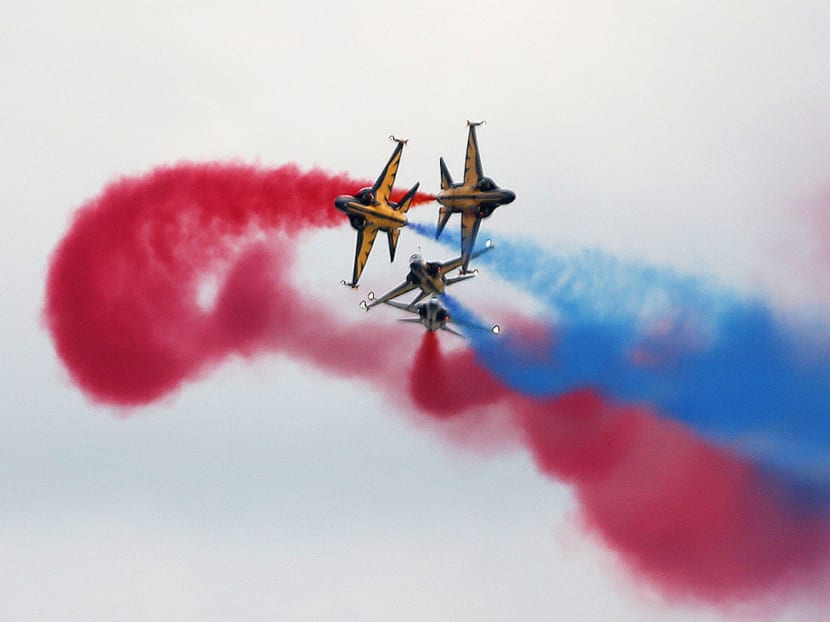Aviation has solid growth potential for S’pore in next decade: Tharman
SINGAPORE — Amid a gloomy economic outlook, aviation remains a bright spot in Singapore’s future, presenting substantial growth potential in the next decade and beyond, said Deputy Prime Minister Tharman Shanmugaratnam yesterday.

The Republic of Korea Air Force Black Eagles aerobatic team performing an aerial display during the Singapore Airshow 2016 official media conference. Photo: Don Wong
SINGAPORE — Amid a gloomy economic outlook, aviation remains a bright spot in Singapore’s future, presenting substantial growth potential in the next decade and beyond, said Deputy Prime Minister Tharman Shanmugaratnam yesterday.
He was speaking at the opening dinner of the Singapore Airshow Aviation Leadership Summit, ahead of the Singapore Airshow, which kicks off tomorrow. Mr Tharman said rising affluence and rapid expansion of the middle-class in Asia is fuelling the demand for air travel, and the current low oil prices can be used to “open the skies further”.
Mr Tharman, who is also Coordinating Minister for Social and Economic Policies, said limiting air traffic rights, and restricting ownership and control not only limit travellers’ options, but also hamper innovation among airlines. “In short, it prevents economies from performing at their full potential,” he said.
“If we do this right, we can maximise the spillovers to growth in our own economies and globally ... If we stick with the status quo, or worse, drift into further protection, we will not only hamper the growth of aviation, but also weaken its potential to stimulate economic growth,” he added.
Citing how a number of flight routes departing from Changi Airport are served only by foreign airlines, Mr Tharman said: “Our end-goal is not the success of Singapore Airlines, but the vibrance of the Singapore air hub.”
To ensure that infrastructure keeps up with air traffic growth, work is under way to expand Changi Airport, which will soon see its fourth and fifth passenger terminals, slated to open in 2017 and in the second half of the 2020s, respectively. Also in the works is a three-runway system, which will be able to handle larger passenger aircraft.
“We want to avoid congestion in the air and on the ground. It hurts growth, and is a negative for both passengers and the environment,” Mr Tharman said.
Developing human capital to meet current and future needs in the sector is another critical priority, he said. In Singapore, this is done through the national SkillsFuture initiative, said Mr Tharman. “We know we cannot rely on the education that people get before they get into a job, that they (learn) when they are young ... The skill requirements will keep changing ... This is abundantly clear in the aviation sector,” he said.
The first 20 recipients of the SkillsFuture Study Awards for the air transport sector — a S$5,000 monetary award that can be used to defray expenses for a range of aviation-related courses — was a diverse group of mid-career individuals, with an average age of 41 and various education qualifications.
Apart from human capital, deploying technology across the aviation value chain is another priority to unlock the sector’s potential, he said.
Citing innovations pioneered by Australia and some European countries, such as passenger self-service and automated aircraft pushback technologies, he said: “We are keenly exploring how we can adopt these and other innovations in our context.”
Finally, aviation safety is of paramount importance and should take priority in both domestic and international policymaking, said Mr Tharman.
Without naming any specific country, he added: “We should certainly not let politics lead us to decisions that compromise safety.”
Around 1,000 companies from about 50 countries will be showcasing their wares at the biennial Singapore Airshow, which opens tomorrow. Organisers forecast that the six-day show will rake in at least US$32 billion (S$44.7 billion) worth of deals, matching its record in 2014.
The show will be open to the public on Saturday and Sunday, where visitors can look forward to aerobatic flying displays, which feature the Republic of Singapore Air Force’s F-15SG fighter jets and AH-64D Apache attack helicopters, and the Republic of Korea Air Force’s Black Eagles.
CORRECTION: In an earlier version of this article, we reported that Changi Airport's fifth terminal is slated to open before 2025. This is incorrect. It is expected to be completed in the second half of the 2020s. We apologise for the error.






